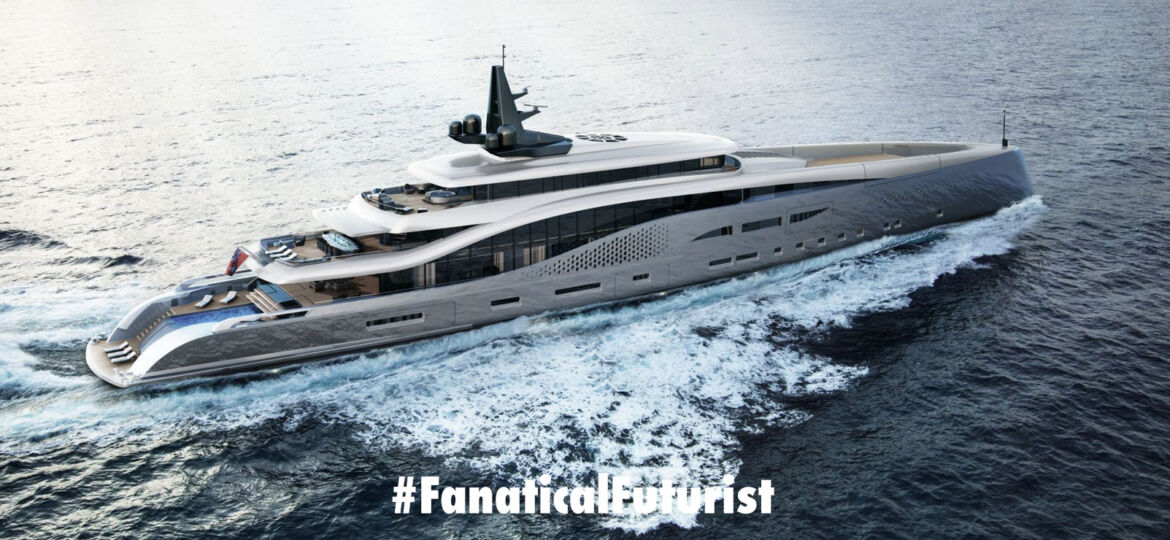
WHY THIS MATTERS IN BRIEF
As the superyacht industry hots up and competition intensifies superyacht companies have to work harder to stay at the leading edge of design trends.
Firstly, I’d like to thank the team at RWD, a superyacht design company in the UK, and Feyi and Rory from SuperyachtNews, who then published a follow up article, for inviting me to present at The Superyacht Design Forum 2018 held at the prestigious and exclusive venue of Chelsea Harbour in London where an eclectic mix of super, mega and gigayacht designers, manufacturers, operators and owners intermingled with each other among the fine silks and bullet proof ceramic armour plating. And with owners paying anywhere between $250 million for a 100 meter superyacht to over $ 500 million for a 200 meter gigayacht it could be argued that the race to create the ultimate “futuristic superyacht,” such as the 106 meter long Black Pearl, has never been hotter.
Unfortunately the video from the event hasn’t been made public but you can see my slides below, and an excerpt from my talk in the promo video. During the presentation, which took a hard and fast look at the role that materials will play in the role of future superyacht design and the industry as a whole, and in the future the creative AI’s working in the backrooms, I walked the audience through the world of revolutionary materials that will not only revolutionise the way superyachts are built, designed, maintained, operated, and protected, but that will also help the industry improve its green credentials.
View the Promo Reel
The first topic I discussed was how new materials will help yacht owners achieve a zero carbon fuel footprint, and help them move from a point today where their yachts are fuelled by diesel or hydrogen fuels to a time where the yachts themselves are battery-less and, essentially, fuel-less. And just to be clear here, as you’ll see I’m not talking about yachts with batteries here, I’m talking about the emergence of revolutionary new materials, like the ones being designed by MIT and Lamborghini, that will let yacht owners dispense of the batteries, that is when electric vessels emerge, once and for all, and turn the very fabric of the superyachts, from the sofas in their spacious lounges to the hulls themselves, into energy generation and storage devices.
Getting to the point where we see the emergence of the first battery-less yachts though will, needless to say, take a while. In between now and then the journey to realise the first generation of these yachts will be filled with many steps that help yachts become increasingly green and sustainable, such as the emergence of omniphobic hull coatings, which even though they aren’t an energy source can nevertheless help reduce the amount of fuel, or energy, superyachts need to cut through the water, by up to 80 percent.
From an energy perspective these include the intelligent use of initially Lithium Ion and then solid state and polymer battery systems, which will charge superyachts in seconds, that will be augmented by zero energy air conditioning units that can cool vessels down to any temperature without using any energy, and new marine resistant photovoltaic materials, from transparent solar concentrators built into energy generating windows, to new flexible bacterial, perscovite and silicon solar panels that work in cloudy conditions as well as generating electricity from rain and water – ideal when travelling at sea.
Over time though as the energy efficiency of tomorrow’s battery systems improve we’ll continue to see the emergence of triboelectric materials and carbon nanotube energy systems, that can be embedded into any type of material, from the 3D printed carbon fiber superstructures to the composites, fabrics and glass used throughout the vessels, and whose properties are so amazing they can even turn plain old paper into a battery.
Next up came entertainment, and here too new materials are going to change how and where owners are entertained. As increasingly flexible, thin, transparent and rollable displays that, in some cases, eventually, will be only atoms thin, find their way into the market superyacht designers will be able to turn entire rooms into fully immersive environments that make even virtual reality start to look tame. Add in the concept of personalised climates, and personalised sound where each person in the room only listens to the sound source they’re interested in, a development from Israeli company Noveto, and you begin to revolutionise how owners and guests on these mighty vessels are entertained. And that’s before we discuss the evolution of augmented, mixed and virtual reality, or 11k TV screens whose definition is so high they have a natural 3D effect.
Of course no superyacht would be complete without protective materials, so as I got into the last stretch, I entered the weird world of atomic knot materials, spray on materials that can be easily applied to the yachts superstructures to make them almost indestructible, metamaterials that can keep yachts connected anywhere in the world, and breakthroughs in 3D printed glass, biofabricated leathers that are grown without the need to ever go anywhere near a cow, and wood that’s stronger than steel. Then, as the half an hour drew to a close I wrapped up showing the audience breakthroughs in synthetic biology that one day might let them grow, not build, their own superyachts.
But that’s a story for another time…
















